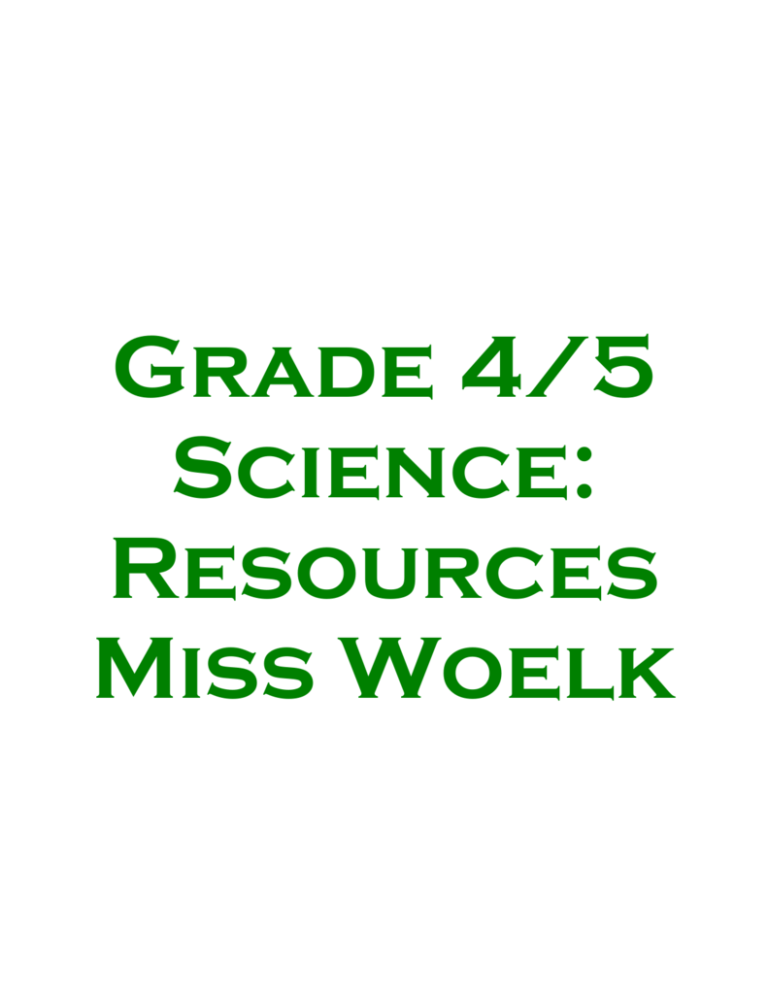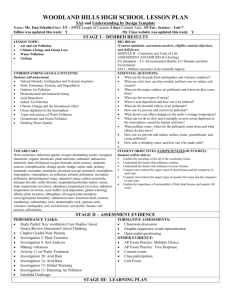File - Krista Woelk
advertisement

Grade 4/5 Science: Resources Miss Woelk Introduction Topic Statement: Rationale: Common Essential Learnings Understanding to Action: Students will apply their knowledge to make a difference in their resource consumption practices Communication: Students will discuss different topics, work together, and work cooperatively Numeracy: Students will measure, collect, and organize data Critical and Creative Thinking: Students will recognize the problems existing in our environment and come up with practical solutions they can carry out. Technological Literacy: Students will look at a waste treatment plant and learn how it works Personal and Social Values and Skills: The students will respect their responsibility as being stewards of God’s creation Unit Concepts Renewable and non-renewable resources Natural and mineral resources Pollution Conservation Erosion Unit Objectives Foundational and Learning Objectives 1. Describe Saskatchewan’s natural resources 1. List resources found in Saskatchewan 2. Classify resources as renewable and non-renewable 3. Distinguish resources used for energy and those used for goods 4. Recognize global concern for air, soil, and water 2. Describe human impact on the environment 1. Importance of proper waste disposal 2. Water cycle 3. Water pollutants and their sources 4. Waste water treatment 5. Air pollutants and their sources 6. Soil pollution 7. Soil erosion and degradation 8. Prevention of soil loss Instructional Strategies: Adaptive Dimension Learning Environment: Cross-Curricular Components Content Outline: Timeline Curriculum Objectives Sask. Natural Resource s Unit Content List resources found in Sask. Classify resources as renewable and nonrenewable Distinguish those used for energy and Lesson Focus 1. Resources – use map of Sask. to find them (add diamonds to student’s lists). What is a resource, natural Assessment Tools goods Recognize global concern for air, soil, and water and mineral resources 2. Renewable and non-renewable: definitions, classify a list of resources as renewable and nonrenewable in groups of 2-3 students and have each group give their reason for R. or N.R. Discuss as a class 3. Resources used for energy and goods: What resources are used for energy and what are used for goods. How are they turned into energy or goods? Where does energy come from? What are our everyday things made of? Activity from WILD pg 335. We need to be good steward of the earth and all that is in it: Gen 1:26- 4. Human impact on the environm ent Water cycle Water pollutants and their sources Importance of proper waste disposal Was water treatment Air pollutants and their sources Soil pollution and its sources Soil erosion and degradation Prevention of soil loss 1. 2. 3. 4. 5. 30 On Going Activity: “Doing Our Part” – have students list ways they can help to reduce the amount of resources they use and document this in a journal To compromise or not to compromise WILD pg 295 Proper waste disposal: chemicals leaching into ground water, different materials need to be disposed of properly – electronics, chemicals and paint, plastic, cardboard, paper, look at recycling Water cycle: draw/label diagrams, how do we benefit from water, how much drinking water do we have activity Water pollutants: what pollutes our water? How do we get acid rain and how does it affect the environment, where do these pollutants come from, how does this affect us? (WILD pgs 191 and 231 – info pages) Waste water treatment: what happens when we flush activity (Super Bowl Sunday from WET), how does a treatment plant work, label diagram, field trip??? 6. Air pollutants and their sources: what is air pollution, causes, how to reduce (“Doing our part”), smog and acid rain, health problems related, list ways to reduce, what can we carry out? What types of pollution are there? The role trees play in air purification 7. Soil pollution and sources: what is soil pollution, Deadly Links pg 299 WILD, how do you know its there, what causes it? How does this affect us (land shortage, leaching into ground water, spraying, dusting, food quality in crops is reduced 8. Soil erosion and degradation: causes – natural (wind, water) man caused (dirty 30’s, farming practices), soil types (some more prone than others) preventions – riparian areas, leaving stubble Finish unit with visit to “Doing our Part” activity Project Wet Project Wild Materials and Resources Assessment and Evaluation Templates Lesson Plans # Lesson ideas evaluation






